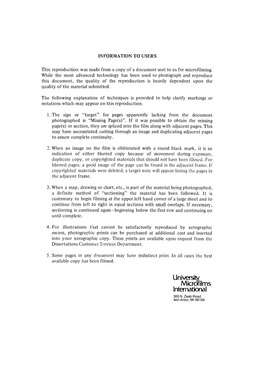| dc.contributor.author | Mcclaren, Cort Alan, | en_US |
| dc.date.accessioned | 2013-08-16T12:29:23Z | |
| dc.date.available | 2013-08-16T12:29:23Z | |
| dc.date.issued | 1985 | en_US |
| dc.identifier.uri | https://hdl.handle.net/11244/5357 | |
| dc.description.abstract | The evaluation instrument consisted of four bipolar adjective scales; (1) sensitive-insensitive, (2) good-bad, (3) effective-ineffective, (4) positive-negative. The scales, each consisting of seven steps, were converted into numerical values allowing for the computation of means. Analyses of variance, follow-up procedures, and the sign test were then computed for each scale. | en_US |
| dc.description.abstract | A number of variables influence one's response to musical performance. Although it is traditionally judged on its "aural" content, judgments concerning the perceived quality of "live" musical performance may be strongly affected by the listener's evaluation of "visual" stimuli. | en_US |
| dc.description.abstract | Means comparison for Scale 1 indicated that listeners rated visual/aural (V/A) presentations higher than aural (A) presentations and rated "positive" performers higher than "negative" performers. Although cell means varied for Scales 2, 3, and 4, the ANOVA and the Tukey Wholly Significant Difference value for each scale revealed similar results. Data indicated a significant difference between positive and negative performers in both the A and V/A modes, but a significant difference between the A and V/A evaluation only for the positive performers. Aural and V/A performances by negative performers were not significantly different. The sign test yielded similar results as those produced by analyzing cell means of Scales 2, 3, and 4. | en_US |
| dc.description.abstract | The purpose of this study was to determine whether solo marimbists' visual attributes influence listeners' perceived quality assessment. In addition, the study sought to determine the differential influence of marimbists exhibiting either "positive" or "negative" impact. | en_US |
| dc.description.abstract | Seventeen marimbists were selected to video record a solo performance. After a panel of experienced listeners viewed the recorded performances, the marimbists were designated as either "positive" or "negative" based upon an overall evaluation of their performance. Three performers from each of the two categories were randomly selected and evaluated by thirty-seven subjects. | en_US |
| dc.description.abstract | This study provides evidence that listeners tend to rate V/A performances higher than aural-only presentations, especially when the performance is "positive". It also suggests that performers having "positive" affect are preferred over those identified as having "negative" affect. | en_US |
| dc.format.extent | xi, 147 leaves : | en_US |
| dc.publisher | The University of Oklahoma. | en_US |
| dc.subject | Marimba. | en_US |
| dc.subject | Education, Music. | en_US |
| dc.title | The influence of visual attributes of solo marimbists on perceived qualitative response of listeners / | en_US |
| dc.title.alternative | The influence of visual attributes of solo marimbists ... | en_US |
| dc.type | Thesis | en_US |
| dc.thesis.degree | Ph.D. | en_US |
| dc.note | Source: Dissertation Abstracts International, Volume: 46-08, Section: A, page: 2223. | en_US |
| ou.identifier | (UMI)AAI8524079 | en_US |
| ou.group | Other | |
